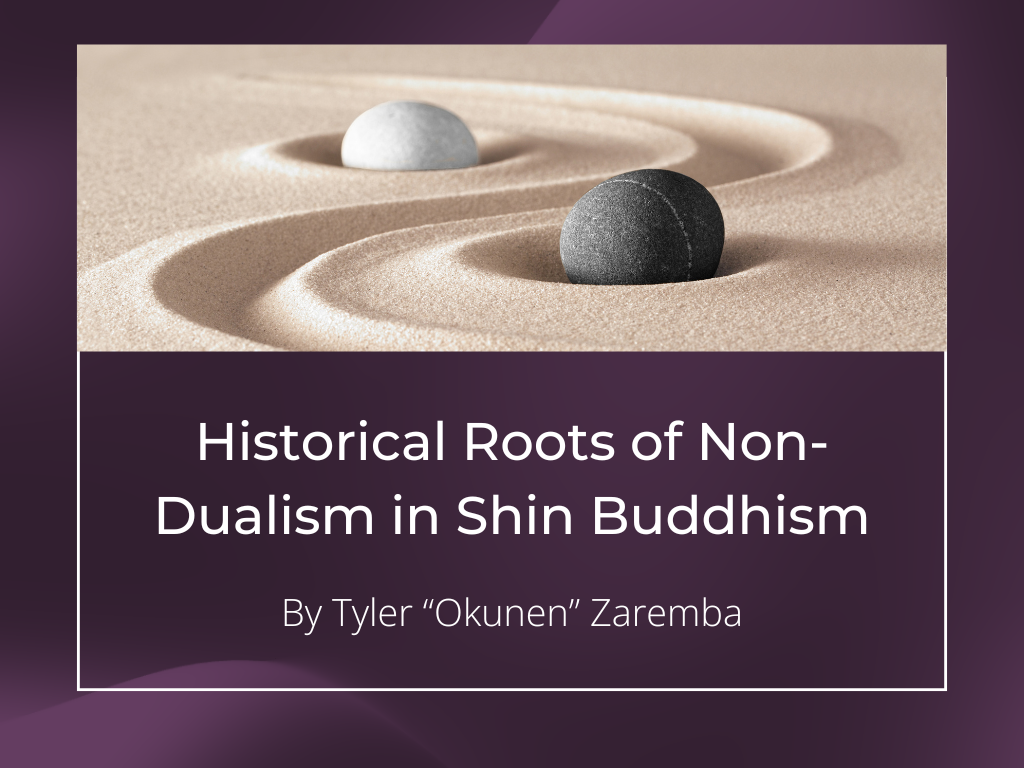Today’s post is from a guest blogger, Tyler “Okunen” Zaremba. Mr. Zaremba is a BCA member as well as a virtual member of Ekoji. In addition to his involvement in the Shin Buddhist community, he is also a member of Everyday Buddhist. We are so happy to feature this blog post on the historical roots of non-dualism in Shin Buddhism.
Historical Roots of Non-Dualism in Shin Buddhism
By Tyler “Okunen” Zaremba
Is Amida Buddha a separate entity or an aspect of our own mind? Is the Pure Land a post-mortem destination or located in the mind here and now? Such questions demand an either or response. Non-duality allows for it to be both either or at the same time. Nonetheless, opinions remain that interpreting Amida Buddha or the Pure Land as mind-only is a modern interpretation. Non-dualistic views in Shin Buddhism are not a modern interpretation but one rooted in the Mahayana tradition from which Shin Buddhism developed. Too often we get bogged down in dualistic thinking that something is either A or B. Non-dualistic thinking breaks the chains of this false dichotomy and allows us to embrace either or.
From Mahayana Sutras, to Jodo Shinshu Patriarchs, and Shinran’s Kyogyoshinsho, we see non-dualism. But what is non-dualism? It refers to the view that apparent opposites like the self and others are interdependent on one another and ultimately the same. The Heart Sutra famously states “form is emptiness, emptiness is form.” Other major Mahayana sutras such as the Diamond Sutra, the Avatamsaka Sutra, and the Lotus Sutra also expound the illusion of distinctions and the interdependence of all phenomena. Shinran, a former Tendai monk, would have been familiar with these Sutras from when he studied at Mt. Hiei.
Born in 150 CE in India, Nagarjuna, the first patriarch of Jodo Shinshu, wrote extensively on the emptiness of all phenomena and non-duality. He helped pave the way for Mahayana and Pure Land thought. The second patriarch of Jodo Shinshu, Vasubandhu, was born in the 4th century CE in India. Vasubandhu further developed the doctrine of non-duality and founded the Y ogacara school which taught that all things are made from the mind. Born in the 5th century in China, Tan-luan, the third patriarch of Jodo Shinshu, wrote “[T]here is no Buddha apart from the mind. It is just as fire is not separate from wood, it burns the wood. The wood becomes fire, which burns the wood and turns it, too, into fire.” This quote comes from Tan-luan’s Commentary on Vasubandhu’s Discourse on the Pure Land and is quoted by Shinran in the Kyogyoshinsho.
Shin Buddhism does not exist in a vacuum but is a part of the Mahayana tradition which historically expounds the doctrine of non-duality. This does not mean that Amida Buddha only exists in the mind. Rather, Amida Buddha transcends the duality of the mind and not mind. Using non-duality helps us from seeing everything as black or white. Arguments over whether Amida Buddha and the Pure Land are mind only or not misses a key point. That point is to see through such dualistic concepts such as form and emptiness, black and white, and mind and not mind. Amida Buddha’s boundless wisdom and compassion transcends duality and illuminates all, no matter one’s interpretation.



Add Your Comment